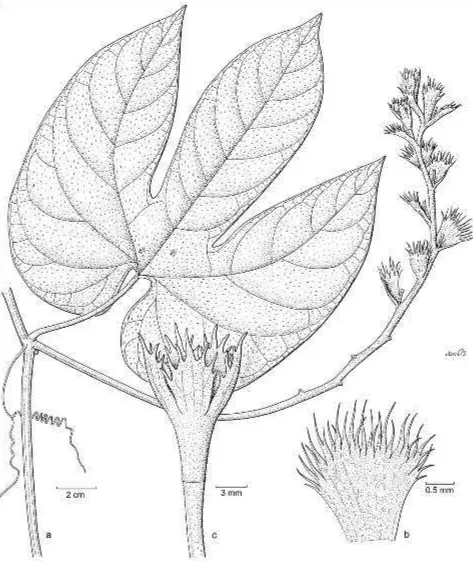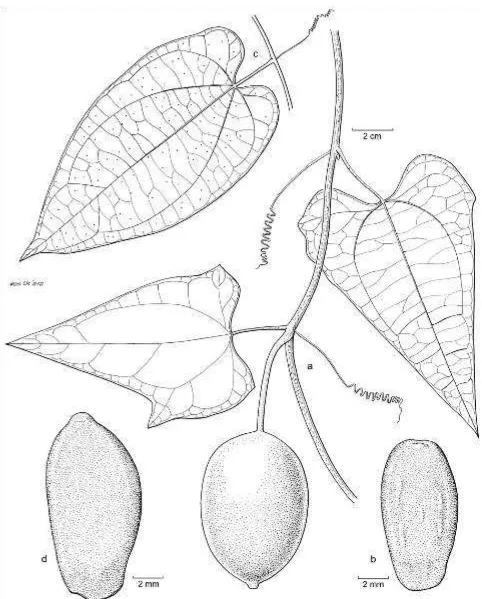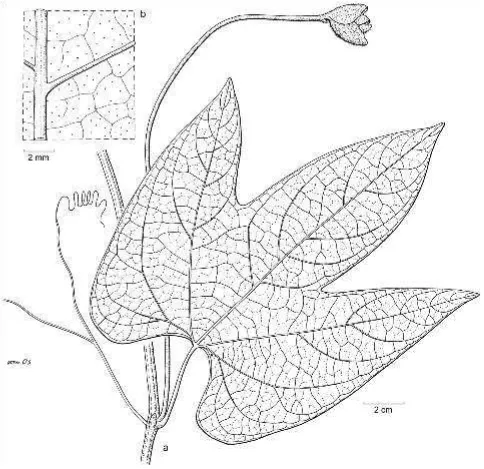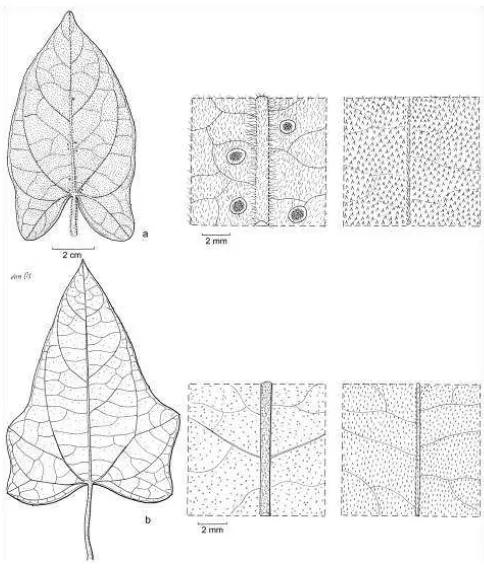REINWARDTIA
A JOURNAL ON TAXONOMIC BOTANY,
PLANT SOCIOLOGY AND ECOLOGY
Vol. 13(3): 221 —315, April 11, 2012
Chief Editor
KARTINI KRAMADIBRATA
Editors
DEDYDARNAEDI (INDONESIA)
TUKTRIN PARTOMIHARDJO (INDONESIA) JOENI SETIJO RAHAJOE (INDONESIA) TEGUHTRIONO (INDONESIA)
MARLINAARDIYANI (INDONESIA) EIZI SUZUKI (JAPAN)
JUN WEN (UNITED STATE OF AMERICA)
Managing editor
HIMMAH RUSTIAMISecretary
ENDANG TRI UTAMI
Lay out
DEDEN SUMIRATHIDAYAT
Illustrators
SUBARIWAHYUDI SANTOSO ANNE KUSUMAWAIY
Reviewers
BRYAN SIMON (AUSTRALIA), EVE J. LUCAS (UNITED KINGDOM), J.F.VELDKAMP (NETHERLANDS), LAUR-ENCE SKOG (USA), PIETER BAAS (NETHERLANDS), RUTH KIEW (MALAYSIA), ROBERT J. SORENG (USA), HE-LENA DUISTERMAAT (NETHERLANDS), LYN A. CRAVEN (AUSTRALIA), RUGAYAH (INDONESIA), MARK HUGHES (UNITED KINGDOM), MARTIN CALLMANDER (USA), PETER C. VAN WELZEN (NETHERLANDS), WAYNE TAKEUCHI (USA), NOBUYUKI FUKUOKA (JAPAN).
Correspondence on editorial matters and subscriptions for Reinwardtia should be addressed to:
HERBARIUM BOGORIENSE, BOTANY DIVISION,
RESEARCH CENTER FOR BIOLOGY-LIPI,
CIBINONG 16911, INDONESIA
REINWARDTIA Vol 13, No 3, pp: 221 − 228
221
entire, erroneously seen as such in the following rather deficient male flowering collections of
Sumbing SAN 116679, Sumbing SAN 110399, and
Jaheri 1570. The plant in the collection of C. Hose 751 is somewhat stouter as hitherto known, with the leaf blade ca. 20 by 17.5 cm and the male peduncle
ca. 15 cm long. Female flowers of this species are still not known.
(2) RE-DESCRIPTION OF TRICHOSANTHES CELEBICA Cogn.
When conceiving T. celebica Cogn. (1881: 385) for the revision of Trichosanthes (Rugayah, 1999; de Wilde & Duyfjes, 2010), it was assumed that the following four collections from E. Sulawesi:
Beccari 51 (type, consisting of a male specimen and one fruit), Kjellberg 1212 (male, BO, S, not seen by de Wilde at the time, though recently we could
examine and identify the S-duplicate as
T. tricuspidata Lour.), de Vogel 6136 (fruit), and de Wilde & Duyfjes 21903 (sterile), and one from Buru: Nooteboom 5275 (sterile) all belonged to that species. have emerged and are described below. It concerns (1) a correction of the description of the male sepals of T. obscura Rugayah (Borneo), (2) the re-description of T. celebica Cogn. (Sulawesi), (3) the description of a new species, T. pedicellata W.J. de Wilde & Duyfjes (Sulawesi), (4) the description of a new variety of T. edulis Rugayah: var. punctata
W.J. de Wilde & Duyfjes (Philippines), and (5) some notes on incomplete material of an undescribed, unidentified species of Trichosanthes
(New Guinea).
(1) THE SEPALS OF THE MALE FLOWERS OF TRICHOSANTHES OBSCURA Rugayah (REINWARDTIA 11 (1999) 269).
Through an old collection (C. Hose 751 (K)), Sarawak, erroneously annotated as collected in North Sulawesi which had at the time escaped from our attention it now became evident that the male sepals of T. obscura are distinctly narrowly lobed (Fig. 1). They were previously described (Rugayah & de Wilde, 1999; de Wilde & Duyfjes, 2010) as
TRICHOSANTHES (CUCURBITACEAE) IN MALESIA: ADDITIONS AND
CORRECTIONS, INCLUDING A NEW SPECIES AND A NEW VARIETY
ReceivedSeptember 7, 2010; accepted June 14, 2011
W.J.J.O. DE WILDE & BRIGITTA E.E. DUYFJES
Netherlands Centre for Biodiversity Naturalis (section NHN), Leiden University P.O. Box 9514, 2300 RA Leiden, The Netherlands. E-mail: duyfjes@nhn.leidenuniv.nl
ABSTRACT
DE WILDE, W.J.J.O. & DUYFJES, B.E.E. 2012. Trichosanthes (Cucurbitaceae) in Malesia: additions and corrections, including a new species and a new variety. Reinwardtia 13(3): 221–228. Recent discoveries in Trichosanthes (Cucurbitaceae): including the re-description of T. celebica, T. pedicellata spec. nov., and T. edulis var. punctata var. nov. are presented.
Keywords: Cucurbitaceae, Trichosanthes, South East Asia, Sulawesi, Philippines, New Guinea.
ABSTRAK
DE WILDE, W.J.J.O. & DUYFJES, B.E.E. 2012. Trichosanthes (Cucurbitaceae) di Malesia: tambahan dan koreksi,
termasuk pertelaan satu jenis baru dan satu varietas baru. Reinwardtia 13(3): 221–228. Rekaman baru dalam Trichosanthes (Cucurbitaceae): termasuk pertelaan kembali jenis T. celebica, T. pedicellata spec. nov., dan T. edulis
var. punctata var. nov. dipaparkan.
REINWARDTIA
222 [VOL.13
preparation), this plant came located in the provisional cladograms wide apart from those of the group to which T. celebica and close relatives like
T. elmeri Merr., T. wawrae Cogn., and T. papuana
F.M. Bailey belong. de Vogel 6136 appeared to link up with species from New Guinea, at present grouped in section Edulis Rugayah. This prompted
us to re-examine the specimen morphologically and also to see the type of T. celebica (FI) again. We concluded that the collection of de Vogel 6136 is quite different in many details, e.g. in its leaf blade glands and seeds and further on it is described as the new species T. pedicellata. Most likely here also belongs Nooteboom 5275 from Buru.
2012] DE WILDE & DUYFJES: Trichosanthes (Cucurbitaceae) in Malesia 223
The description of the new species implies that the hitherto accepted description of T. celebica
(Rugayah, 1999; de Wilde & Duyfjes, 2010) should be amended, excluding de Vogel 6136, Nooteboom 5275, and Kjellberg 1212.
TRICHOSANTHES CELEBICA Cogn. (1881) 385; Rugayah & de Wilde (1999) 251, p.p.; Rugayah (1999) 99, p.p., pl. 5a; de Wilde & Duyfjes (2010) 260, p.p. — Type: Beccari 51 (holo FI), SE Sulawesi, near Kendari, Lepo-Lepo. ―Fig. 2c, d.
Climber to 10 m long, early glabrescent, at first with sparse minute hairs, leafy stem 1.5–3 mm diam.; monoecious or dioecious. Probract fine-hairy, ovate, 3–6 by 3–4 mm, glands present.
Tendrils unbranched (or 2-branched). Leaves
petiole 2–4 cm long; petiolules 0.3–0.8 cm long; blade green on drying, chartaceous or membranous, simple and unlobed or 3-foliolate; unlobed blade in outline ovate-oblong or subhastate, 10–18 by 5–8.5 cm, foliolate blade in outline circular, 15–20 cm diam., middle leaflet 10–15 by 3–5(–7) cm, base cuneate, faintly scabrous above, with dense in-conspicuous cystoliths, glands (several or) numerous, scattered, 0.5(–1) mm diam., margin entire or sparsely minutely dentate; unlobed blades with 3(–5) curved basal veins, leaflets pinniveined.
Male raceme minutely rust-hairy; peduncle 2.5–4 cm long, ca. 3 mm thick; rachis somewhat thickened, with bract-scars, 5–11 cm long, 8– 15-flowered; bracts subpersistent, oblong-lanceolate, 15–25 mm long, fine-hairy, base attenuate, 3– 5-nerved, apex deeply incised, with glands. Male flowers (from buds): pedicel 1–2(–3) mm long; buds fine-hairy; sepals narrowly triangular, 6–7 mm long, entire. Female flowers not known. Fruit rip-margin absent, edge entire.
Distribution. SE Sulawesi (Kendari).
Habitat & Ecology. Open areas in secondary forest or disturbed primary forest, at low altitudes; male flowering and fruiting in July.
Specimens seen. Beccari 51 (♂ fl., fr.); de Wilde & Duyfjes21903, 21909 (both sterile).
Notes. from the first in broader seeds.
3. Trichosanthes celebica as here circumscribed differs from the description in Rugayah & de Wilde (1999), Rugayah (1999), and de Wilde & Duyfjes (2010) in the exclusion of the specimens Kjellberg 1212, de Vogel 6136 and Nooteboom 5275, of
Trichosanthes celebica auct. non Cogn.: Rugayah (1999) 99, p.p., pl. 5a.
A Trichosanthidi celebicae fructibus minoribus ca. 6.5 cm longis, pedicello in fructu longiore 5.5–7 cm longo,
Probract not obvious. Tendrils unbranched. Leaves
REINWARDTIA
224 [VOL.13
2012] DE WILDE & DUYFJES: Trichosanthes (Cucurbitaceae) in Malesia 225
thick. Seeds blackish, compressed, elliptic, 9–10 by 4–4.5 by 2–3 mm, margin absent, edge entire.
Distribution. Sulawesi: Lake Matano area, and possibly Moluccas (NW Buru, Nooteboom 5275, sterile).
Habitat & Ecology. Solitary climber in disturbed primary forest on alluvial flat, deep hard red clayey soil derived from conglomerate bedrock; 400 m altitude. Fruiting in July.
Notes.
1. Trichosanthes pedicellata differs from
T. celebica in the aspect of its leaves with very crowded numerous cystoliths on the upper surface and without or with only few glands at the base, and in its smaller fruit with smaller and thicker seeds and with a longer fruiting pedicel. In T. celebica the cystoliths are fewer and barely visible, the blade glands numerous and scattered all over the blade, the fruit larger with larger much flattened seeds, and the fruiting pedicel is shorter (see Fig. 2).
2. According to molecular studies by de Boer (mentioned above), T. pedicellata rather belongs to the New Guinean section Edulis, but the seed in that section is different: more angular in shape, more flattened and often truncate or emarginate at one end.
(4) A NEW VARIETY IN TRICHOSANTHES EDULIS, THE TYPE SPECIES OF
TRICHOSANTHES SECTION EDULIS Rugayah
To date it was assumed that Trichosanthes sect.
Edulis, with 8 species, was confined to New Guinea (Rugayah, 1999; de Wilde & Duyfjes, 2010). However, a recent accession from the Philippines, Luzon, Barbon, Romero & Fuentes PPI 13044, clearly belongs to this section. It consists of a leafy twig-portion with an unusual long-peduncled immature male inflorescence, obviously most closely resembling T. edulis.
The discovery of PPI 13044 means a large range extension of the species T. edulis, as well as a remarkable one of the section Edulis, now also known as occurring in the Philippines. The specimen may represent a new species, but for assessing this more complete material is necessary.
As for the present, however, the species is sufficiently resembling T. edulis (with 3 varieties in New Guinea) to describe it as a new fourth variety. Trichosanthes edulis Rugayah var. punctata W.J. de Wilde & Duyfjes, var. nov. ― Fig. 3.
A Trichosantidis edulis varietatibus omnibus foliis abaxialiter glandulis punctatis atrobrunneis minutis,
pedunculo masculo longo ca. 25 cm longo differt. — Typus: Barbon, Romero & Fuentes PPI 13044, 05 July 1994 (holo L; iso PNH, not seen), Philippines, Luzon.
Plant subglabrous, except finely hairy male peduncle and woolly hairy male bracts. Probract
narrowly ovate, ca. 7 mm long, acute. Tendrils 2-branched. Leaves petiole 4.5–6 cm long; blade dry-ing brown-greenish, simple, 3-lobed to nearly
half-way, ca. 20 by 17 cm, abaxially coarsely reticulately veined and with numerous dark brown dots (gland hairs?), blade glands absent or a single one at very blade-base, ca. 1 mm diam., margin entire. Male inflorescence: peduncle ca. 25 cm long, male bracts broadly elliptic or ovate, ca. 20 by 20 mm, densely brown woolly hairy, hairs ca. 1 mm long, margin shallowly dentate-crenulate in lower half, apex subacute or bluntish. Male and female flowers and fruit not known.
Distribution. Philippines: Luzon, Isabela Province, where only known from the type.
Habitat & Ecology. In secondary disturbed forest on loam, at 200 m altitude. Flowering (buds): July.
(5) UNIDENTIFIED SPECIMENS
The section Edulis seems one of the best defined sections of Trichosanthes, however, far from completely known, as testified by two un-named collections obviously representing new species in this section but waiting for additional material to be described formally. It concerns:
REINWARDTIA
226 [VOL.13
2012] DE WILDE & DUYFJES: Trichosanthes (Cucurbitaceae) in Malesia 227
REINWARDTIA
228 [VOL.13
RUGAYAH. 1999. Trichosanthes (Cucurbitaceae) in Malesia. Thesis: 239 pp. Program Pasca Sarjana Institut Pertanian Bogor.
RUGAYAH & DE WILDE, W. J. J. O. 1999. Conspec-tus of Trichosanthes (Cucurbitaceae) in Malesia. Reinwardtia 11 (4): 227–280.
REFERENCES
COGNIAUX, C. A. 1881. Cucurbitaceae. In A. DE CANDOLLE & C. DE CANDOLLE. Monographiae Phanerogamarum Prodromi 3: 325–951.
314 REINWARDTIA [VOL.13
ERRATUM
REINWARDTIA Vol. 13, Part 2, 2010
1. Please change the existing word in p. 213, LINE 7 on ABSTRAK (written in Bahasa Indonesia version) with the following:
Keberadaan dua jenis terakhir melampaui distribusi yang sebelumnya hanya diketahui di barat garis Wallace.
2. Please change the existing epithet name in p, 214, COLUMN 1, LINE 40 on Key to the species of
Marantaceae in Sulawesi number 5.a. after Phrynium:
INSTRUCTION TO AUTHORS
Reinwardtia is a scientific journal on plant
taxonomy, plant ecology, and ethnobotany. Manuscript intended for a publication should be written in English represent an article which has not been published in any other journal or proceedings. Every manuscript will be sent to two blind reviewers.
Two printed copies (on A4 paper) of the manuscript of not more than 200 pages together with an electronic copy prepared on Word Processor computer program using Time New Romance letter type and saved in Rich Text File must be submitted.
For the style of presentation, authors should follow the latest issue of Reinwardtia very closely. Title of the article should be followed by authors name and mailing address in one-paragraphed English abstract of not more than 250 words. Keywords should be given below each abstract. On a separated paper, author(s) should send the preferred running title of the article submitted.
Taxonomic identification key should be prepared using the aligned couplet type.
Strict adherence to the International Code of Botanical Nomenclature is observed, so that taxonomic and nomenclatural novelties should be clearly shown. Latin description for new taxon proposed should be provided and the herbaria where the type specimens area deposited should be presented in the long form that is name of taxon, authors name, year of publication, abbreviated journal or book title, volume, number and page.
Map, line drawing illustration, or photograph preferably should be prepared in landscape presentation to occupy two columns. Illustration must be submitted as original art accompanying, but separated from the manuscript. On electronic copy, the illustration should be saved in jpg or gif format at least 350 pixels. Legends or illustration must be submitted separately at the end of the manuscript.
REINWARDTIA
Vol. 13. No. 3. 2012 CONTENTS Page
W.J.J.O. DE WILDE & BRIGITTA E.E. DUYFJES. Trichosanthes (Cucurbitaceae) in Malesia: additions and corrections, including a new species and a new variety 221
DEDEN GIRMANSYAH. Two new species of Begonia (Begoniaceae) from Bukit Tiga-puluh National
Park, Riau, Sumatra 229
PUDJI WIDODO. New nomenclature in Syzygium (Myrtaceae) from Indonesia and its vicinities 235
ALEX SUMADIJAYA & JAN FRITS VELDKAMP. Non-Bambusoid Grasses (Gramineae) from Raja
Ampat Archipelago, Papua Barat Province, Indonesia 241
ARY PRIHARDYANTO KEIM. New variety, records & discoveries of some species of Pandanus
(Pandanaceae) in Sumatra and Kalimantan, Indonesia 255
HARRY WIRIADINATA. A new species of Begonia (Begoniaceae) from Sagea Lagoon, Weda Bay,
Halmahera Island, North Moluccas, Indonesia 263
ARY PRIHARDYANTO KEIM. The Pandan flora of Foja-Mamberamo Game Reserve and Baliem Valley, Papua-Indonesia 271
JAN FRITS VELDKAMP. Koordersiochloa Merr. (Gramineae), the correct name for Streblochaete Hochst. exPilg. 299
SRI ENDARTI RAHAYU, KUSWATA KARTAWINATA, TATIEK CHIKMAWATI & ALEX
HARTANA. Leaf anatomy of Pandanus species (Pandanaceae) from Java 305
Reinwardtia is a LIPI acredited Journal (258/AU 1/P2MBI/05/2010)
Herbarium Bogoriense Botany Division



